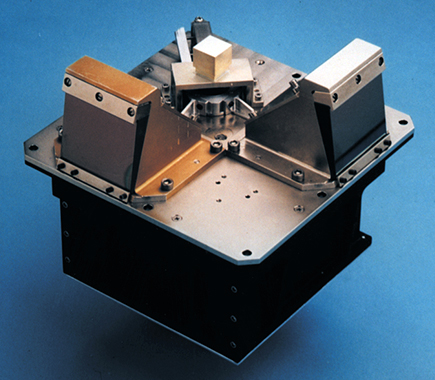Got an Attitude Problem?
Satellites circling the Earth demand precision pointing of sensors, antennas, cameras, and other equipment. Without highly accurate angular positioning of spacecraft, a range of dutiful services would not be possible.
An innovative approach to Earth sensor design has been taken by Servo Corporation of America in Westbury, New York. Through a Small Business Innovation Research (SBIR) award from Goddard Space Flight Center, the company built its Mini-Dual Earth Sensor (MiDES). NASA's support for the work stemmed from interest in evaluating a satellite autonavigation system.
The MiDES is an Earth horizon sensor that provides higher accuracy than other types of units, making use of pyroelectric arrays and a digital output. Servo's lightweight, low-cost, dual array horizon sensor was flown in space, confirming its abilities. MiDES is now being eyed for use on a number of commercial telecommunications satellite constellations and other spacecraft to be built both in the U.S. and abroad.
A state-of-the-art Earth horizon sensor, MiDES combines the versatility of a conical scanner with the accuracy and reliability of a staring sensor. The resulting instrument is a lightweight, low-cost, low-power alternative for low-Earth orbiting satellites. Designed specifically to provide horizon attitude position for Earth circling satellites, the MiDES derives its information through the use of two pairs of pyroelectric arrays positioned 90 degrees apart in the imaging plane. Each 16-element array is spatially separated into two 8-element staggered columns that reject and compensate for light emitted by the Sun and reflected by the Moon. The device detects temperature differences between the Earth and space. An algorithm calculates the position of the horizon based on the voltages obtained from the pixels, which subtend the horizon gradient and the pixels that look at space and Earth.
The heart of the MiDES is the hybridized lithium tantalate pyroelectric array. Created by Servo, these lithium tantalate detectors are specially processed, highly sensitive, uncooled detectors that provide very stable outputs over a variety of temperatures and operating conditions. The need for moving parts has been dramatically reduced to near zero. A flex pivot-mounted chopper design eliminates the need for scanning motors, bearings, and lubricants.
MiDES was used on the STS-85 flight of the Space Shuttle Discovery, carried by the Cryogenic Infrared Spectrometers and Telescopes for the Atmosphere (CRISTA)-Shuttle Pallet Satellite II (SPAS). The CRISTA-SPAS was a joint satellite project between NASA and Germany. Once the satellite was deployed from the Shuttle, it flew for 11 days. Several gigabytes of flight data on how MiDES operated were obtained. These data showed that the MiDES accuracy was significantly better than expected, keeping attitude errors well under 0.1 degrees.
Sales of MiDES have begun, with delivery of a unit for flight on a minisatellite program sponsored by the United Kingdom. MiDES is a candidate for several constellates of low-Earth orbiting telecommunications satellites. A variation of the basic MiDES has also been proposed for use aboard several new geosynchronous satellites being designed.
It seems that MiDES has proven itself capable of locking onto new business, as well as providing a solid lock on the Earth's horizon.

Servo Corporation of America's MiDES is a dual array Earth horizon sensor that provides high accuracy for low-Earth orbiting satellites.













